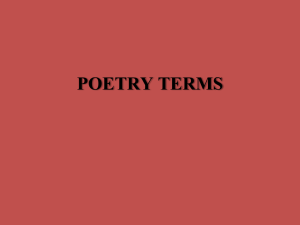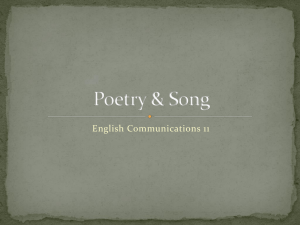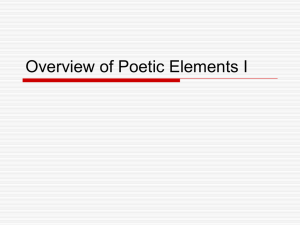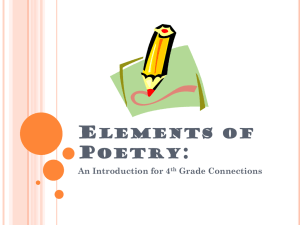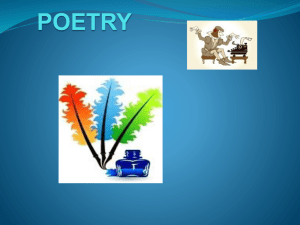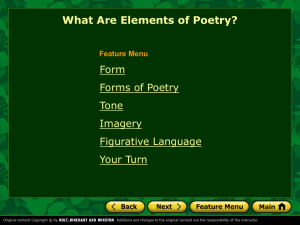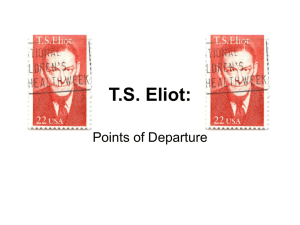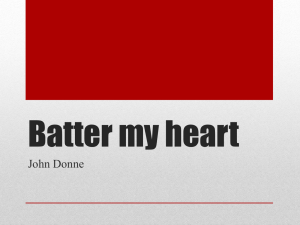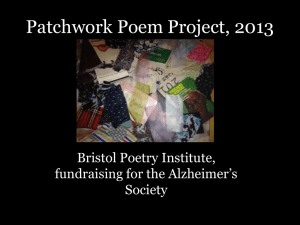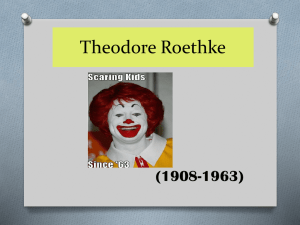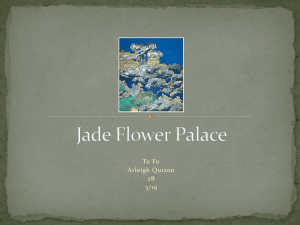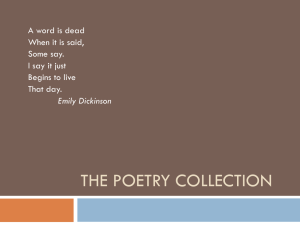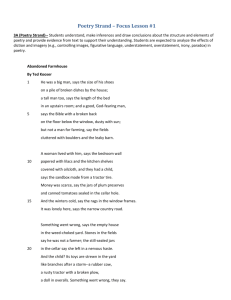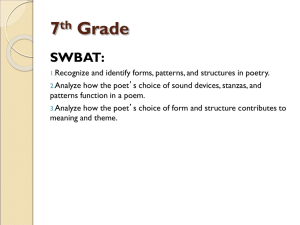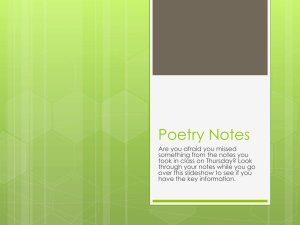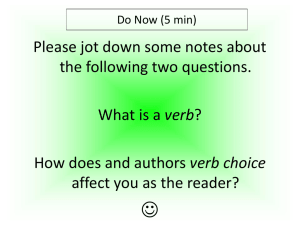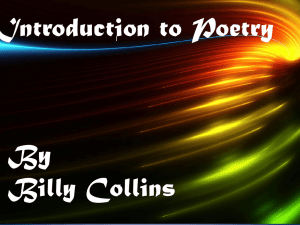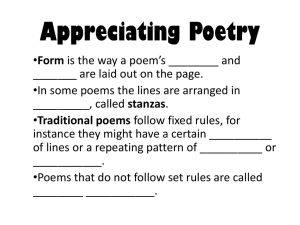File
advertisement
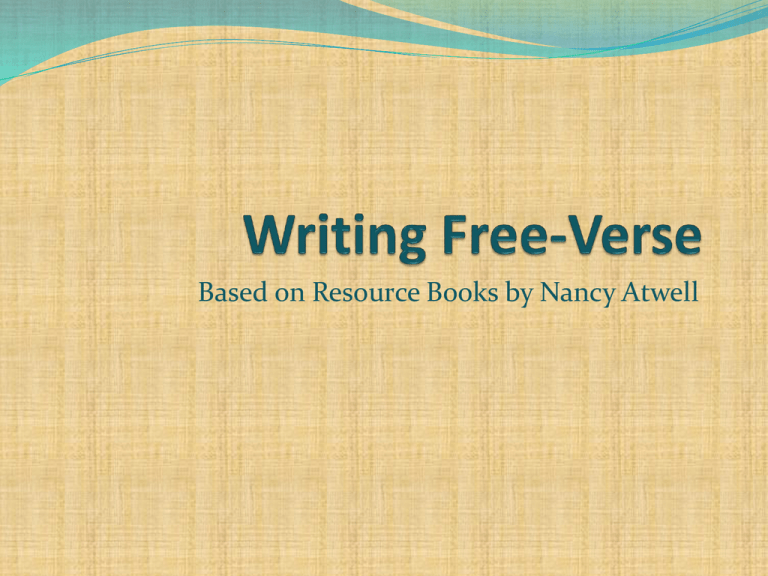
Based on Resource Books by Nancy Atwell Free-Verse ONE DEFINITION OF FREE-VERSE POETRY Free verse is poetry that doesn’t have a regular rhythm, line length, or rhyme scheme. It relies on the natural rhythms of speech. Today it is the form of poetry that most American poets prefer. Free-verse poetry invents and follows its own forms, patterns and rules. Free-Verse poets use the conventions of the genre to create voice, power, and meaning. The Power of I First person experiences need a first person. Make sure your I is present and is thinking, feeling, seeing, acting. Give your readers someone to be with. Find your voice as a poet. Wave your I flag in your poetry. 1st draft- The Power of I Wind The wind rustles the trees Like it does the long grasses of the meadow, commands the water to move in ripples Like tiny mountains and rests in the sails Of a small boat on its way home. Then the wind leaves to rustle other trees Blow through other meadows, Move other tiny mountains and send other small boats home. _Ceysa McKechine Wind- 3rd Draft-Wave your I Flag I listen to the wind rustle through the trees As it does the long grasses in the meadows. I watch as it commands the water to move in ripples Like tiny mountains and rest in the sails of a small boat, Pushing it home. Then the wind abandons the small boat to rustle other trees, Blow through other meadows, command other tiny mountains to move, Send other small boats home. As I watch night begin to settle, I wonder, will I ever find myself in the small boat, Watching the same wind fly over the green landscape, Longing for it to land in my sails and send me home? Beware the Participle What is a participle? A verb in disguise-a verb that functions as an adjective - Participles Participles are -ed and -ing verbs that function as adjectives—for example: The sleeping cat is brown. The freshly picked tomatoes look delicious. I am going to the store. The kids were dropped off at school. http://grammarist.com/grammar/nonfinite-verbs/ Perched on a tree stump Trying to admire the lobster pound woods Looking at the gun metal Grey ashes dancing above Like skeletons rubbing shoulders Watching birch trees surrender their whites Snow sticking in shady spots And tired ancestors of fern waving goodbye Hearing no birds call Except for three gulls circling the pond And screaming at the wind Smelling old air, Not even smelling the balsams, And noticing no signs of what’s to come. But, deep inside, knowing And saying a prayer of thanks For the gifts of imagination and memoryThe twin blessings of the human condition That each spring survive The dismal days of march in Maine. Leads Begin Inside In the words of Horace, one of the greatest lyric poets of all time (65 B.C.E. – 8 B.C.E.), begin poems “in the midst of things.” Start your poems inside ] “ an experience, feeling, observation, or memory Abstract Vs. Imagery An abstraction is anything that is not tangible and does not bring a picture directly to mind. Love, future, grief, and time are all abstractions. Images are anything that are universally seen similarly in our minds. Apples, ladders, and canes are all images – we all see them in a similar way. Conclude Strongly The conclusion often conveys a poem’s deepest meaning. It needs to be strong – to resonate after the reader has finished the poem. The conclusion should leave a reader with a feeling, idea, image, or question. Experiment: try different endings until you find the one that best conveys your meaning. Maybe try an echo structure: repeat significant lines from the lead, or elsewhere, in the conclusion. Give your poem the time it needs for the right conclusion. Breaking lines and Stanzas and Punctuating Poetry is written to be spoken. Break lines to emphasize pauses or silences. Break on nouns, verbs, adjectives, and adverbs. Try to draft your poem in lines. When you revise, insert // between lines to indicate a new line break, and ----------------- between lines to indicate a new stanza break. Experiment with the size, shape, and length of lines and stanzas. In general, you may want to punctuate and capitalize the lines of your poems as if they’re prose, but don’t be afraid to experiment with/without caps and punctuation, either. Rain Lullaby I listen to the rain as it drizzles on our roof And snuggle even deeper Under the warm weight of my covers. My hands open my book, And I begin to read. In a moment I’m lost As the story unfolds. Slowly, slowly, I feel My eyelids turn to lead. I shut my book And turn off the light. Already adrift I close my eyes, So glad to be where I amHalf asleep In the warmth Of my bed With the rain as my lullaby -Molly Jordan About Lines “ I cannot say too many times how powerful the techniques of line length and line breaks are. You cannot swing the lines around, or fling strongsounding words, or scatter soft ones, to no purpose.” - Mary Oliver The Meet Step up. Take your mark. Go. I burst off the starting block, fly through the air, slice into the water, and glide. I stroke, gasp for air until I’m at the end of the pool, where I flip and push off as hard as I can. The screams of the crowd fill my ears as I take one more breath, reach the wall, hit it, WIN. - David MacDonald Stanzas Comes from the Latin word stantia, which means “standing” or “stopping” Later became stanza = “stopping place” or “room” “The stanza-break almost always indicates a pause, however slight, just as you have to slow down to go through a door.” – Ron Padgett The Storm Under gloomy gray skies hanging low . I pulled on my oilskins and climbed into the wooden skiff. I was skeptical; you were not. It’ll clear up, you assured me. So off we set. Before even the first trap was hauled, rain began to trickle down our cheeks and onto the orange rubber of the oilskins. Within a few traps it was streaming from the sky, lashing onto our bowed heads. The Storm (continued) Trap after trap we hauled, and I did my jobs mechanically as we collected our booty; mottled brown and green lobsters. The dog bounded along the seaweedy rocks, trying to keep up with us. I shivered beneath my hood. We pulled into the dock with numbed faces and frozen fingers. I met my black dog under the trees on the shore and with stiff hands tried to unbuckle my soaked life vest as we walked to the boat shop at the top of the hill, as the rain poured down on the blue-gray ocean - Annie Kass About Stanzas “The main thing is to make rooms that are big enough to be useful, shapely enough to be attractive, and not so empty as to be disappointing.” -Rod Padgett “ Poetry is especially the art of compression.” - Robert Wallace “I know a poem is finished when I can’t find another word to cut.” -Bobbi Katz A Little Friendship (cut) We met on an airplane. She was from Germany and on her way to visit her grandmother in the States. We had finished our vacation in Germany and were headed home to Maine. We wrote our addresses on slips of paper and exchanged them. We said good-bye as we collected our baggage. But never saw her again. I lost my slip of paper. First we exchanged visits in our airplane neighborhoods. I think she lost hers too. We listened to music We never wrote to each other. and watched Bugs Bunny videos. So I consider her a brief friend, Then we crawled under seats, one who helped pass the time on a six-hour flight poked people’s feet, and made a memory. and scurried away, - Lucas Mayer trying to suppress our giggles. Near the back of the plane, two brothers played with Batman toys. We despised Batman and chanted an anti-Batman song to the tune of “Jingle Bells.” Cut to the Bone When the poet can’t find another word to cut, a poem is done. Weigh every line and every word: does it do anything for your poem? Does a smart reader need it? And, is it elegant shorthand yet? Use Repetition Beware of ineffective repetition: a word repeated in too close proximity to no purpose or effect and that sounds awkward. Use effective repetition to stress an important word, phrase, idea or theme; to move a poem; to build a poem’s momentum; to create cadence. When you revise, read your poem with your ears and listen for its rhythms. Is this clear? Can you do it? What are your observations? Figurative Language, or Two Things at Once Literal: Language is true to fact. It uses words in accordance with their actual meanings. Eg. My dog is a carnivore Figurative: Language makes comparisons between unrelated things or ideas, in order to show something about a subject. Eg. In the kitchen, when I cook, my dog is a tap dancer. Figurative Language, or Two Things at Once (continued) Three kinds of figurative language: Metaphor: (Greek) means literally transference. The writer transfers qualities of one thing to another thing. A metaphor has two parts: A = B: something is something else. The B part, the something else, shows how the poet feels about or perceives the A part. Eg. Thumb The odd, friendless boy raised by four aunts. - Philip Dasey Figurative Language, or Two Things at Once (continued) Simile (from the Latin similes: similar) : A kind of metaphor that uses like or as to compare two things: A is like B Eg. Thunder threatens Like a sound that rolls around and around in a mean dog’s throat - Martha Sherwood Personification (from the Greek prosopa, meaning “face” or “mask”) : a metaphor that gives human or physical qualities to an object, animal, or an idea. Eg. The yellow fog that rubs its back upon the window panes. - T.S. Eliot
